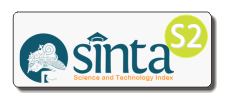The development of science comic to improve student’s understanding in elementary school
Luluk Amalia, Universitas Ahmad Dahlan Yogyakarta, Indonesia
Abstract
This study aims to: (1) understand the steps of science comic development for grade V elementary school students, (2) understand the feasibility of comic science from learning aspect, materials aspect, and instructional media aspect, (3) understand the effectiveness of science comics to increase students understanding in elementary school. This is a research and development by using ADDIE model (Analysis, Design, Development, Implementation, and Evaluation). Product validation tests are carried out by material experts, learning experts, media experts, teacher response, and students respond. Product implementation is conducted on the grade V students of Muhammadiyah Ngijon 1 elementary school. Data collection is used questionnaire and test. The results showed that the assessment from media experts is 81.25 (high feasibility); from the science, material expert is 85.00 (high feasibility); from learning experts is 93.18 (high feasibility). Teachers and students in the small group obtained a value of 97.50 (high feasibility) and in large group trials obtained a value of 94.58 (high feasibility). The effectiveness of science comic is tested by Wilcoxon signed test and the result of Z value at -3.903 on the asimp significance of 0.000 on two-tailed test. The tets result show that the significance value is smaller than alpha (0.05); then it can be concluded that "Ho is rejected and Ha accepted". It means that there are differences in students' understanding of pre-test and post-test in science learning, so it can be concluded that science comis is effective to improve the understanding
Keywords
Full Text:
FULLTEXT PDFReferences
Ahmat, J., & Sukartiningsih, W. (2013). Penggunaan media komik untuk meningkatkan keterampilan membaca cerita di kelas V Sekolah Dasar. JPGSD, 1(2), 1–9. Retrieved from http://jurnalmahasiswa.unesa.ac.id/index.php/jurnal-penelitian-pgsd/article/view/3025
Bhakti, C. P., & Maryani, I. (2016). Strategi LPTK dalam pengembangan kompetensi pedagogik calon guru. Jurnal Pendidikan, 1(2), 98–106. http://doi.org/10.26740/jp.v1n2.p98-106
Branch, R. M. (2009). Instructional design: The ADDIE approach. New York: Springer Science & Business Media. http://doi.org/10.1007/978-0-387-09506-6
Fitkov-Norris, E. D., & Yeghiazarian, A. (2015). Validation of VARK learning modalities questionnaire using rasch analysis. Journal of Physics: Conference Series, 588(1). http://doi.org/10.1088/1742-6596/588/1/012048
Hartono, Y., & Haryanto, S. (2018). Character education in the perspective of humanistic theory : A case study in Indonesia. EDUCARE (International Journal for Educational Studies), 10(2), 95–108. Retrieved from www.mindamas-journals.com/index.php/educare
Hosler, J., & Boomer, K. B. (2011). Are comic books an effective way to engage nonmajors in learning and appreciating Science? CBE Life Sciences Education, 10(3), 309–317. http://doi.org/10.1187/cbe.10-07-0090
Hwang, G.-J., Yang, L.-H., & Wang, S.-Y. (2013). A concept map-embedded educational computer game for improving students’ learning performance in natural science courses. Computers & Education, 69, 121–130. http://doi.org/10.1016/j.compedu.2013.07.008
Lestari, D. I., & Projosantoso, A. K. (2016). Pengembangan media komik IPA model pbl untuk meningkatkan emampuan berfikir analitis dan sikap ilmiah.Jurnal Inovasi Pendidikan IPA, 2(2), 145. http://doi.org/10.21831/jipi.v2i2.7280
Lin, S.-F., Lin, H., Lee, L., & Yore, L. D. (2015). Are science comics a good medium for science communication? The Case for public learning of nanotechnology. International Journal of Science Education, 5(3), 276–294. http://doi.org/10.1080/21548455.2014.94
Liu, Y. (2010). Social media tools as a learning resource.Journal of Educational Technology Development and xchange, 3(1), 101–114. http://doi.org/10.18785/jetde.0301.08
Maryani, I. (2010). Pembelajaran kooperatif GI (group investigation) berbantuan media laboratorium virtual dilengkapi andout untuk meningkatkan kualitas proses dan hasil belajar. Universitas Sebelas Maret.
Maslichah, A. (2006). Penerapan pendekatan sains-teknologi-masyarakat dalam pembelajaran sains di sekolah dasar. Jakarta: Depdiknas.
National Research Council. (2011). Successful K-12 STEM Education: identifying effective approaches in science, technology, engineering, and mathematics.Washington DC: National Academies Press.
Noor, F. M., & Wilujeng, I. (2015). Pengembangan SSP fisika berbasis pendekatan CTL untuk meningkatkan keterampilan proses sains dan motivasi belajar. Jurnal Inovasi Pendidikan IPA, 1(1), 73. http://doi.org/10.21831/jipi.v1i1.4534
Puspitorini, R., Prodjosantoso, A. ., Subali, B., & Jumadi, J. (2014). Penggunaan media komik dalam pembelajaran IPA untuk meningkatkan motivasi dan hasil belajar kognitif dan afektif.Jurnal Cakrawala Pendidikan, 3(3), 413–420. http://doi.org/10.21831/cp.v3i3.2385
Schaal, S., Bogner, F. X., & Girwidz, R. (2010). Concept mapping assessment of media assisted learning in nterdisciplinary science education. Research in Science Education, 40(3), 339–352. http://doi.org/10.1007/s11165-009-9123-3
Suparmi. (2018). Penggunaan media komik dalam pembelajaran IPA di sekolah. Journal of Natural Science and Integration, 1(1), 62–68.
Tekle-Haimanot, R., Preux, P. M., Gerard, D., Worku, D. K., Belay, H. D., & Gebrewold, M. A. (2016). Impact of an educational comic book on epilepsy-related knowledge, awareness, and attitudes among school children in Ethiopia. Epilepsy & Behavior, 61, 218–223. http://doi.org/10.1016/J.YEBEH.2016.05.002
Widyawati, A., & Prodjosantoso, A. K. (2015). Pengembangan media komik IPA untuk meningkatkan motivasi belajar an karakter peserta didik SMP. Jurnal Inovasi Pendidikan IPA, 1(1), 36–45. http://doi.org/10.21831/jipi.v1i1.4529
DOI: https://doi.org/10.21831/jipi.v4i1.21076
Refbacks
- There are currently no refbacks.
Copyright (c) 2018 Jurnal Inovasi Pendidikan IPA

This work is licensed under a Creative Commons Attribution-ShareAlike 4.0 International License.
Jurnal Inovasi Pendidikan IPA indexed by:

Jurnal Inovasi Pendidikan IPA by http://journal.uny.ac.id/index.php/jipi/index is licensed under a Creative Commons Attribution-ShareAlike 4.0 International License.
All rights reserved. p-ISSN: 2406-9205 | e-ISSN: 2477-4820
Statcounter View My Stats














